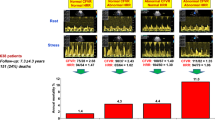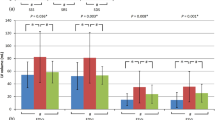Abstract
High-dose dipyridamole transesophageal stress echocardiography has recently been proposed as a useful and safe method to assess myocardial ischemia in patients with a poor transthoracic acoustic window. It has also been shown that transophageal echocardiography (TEE) allows the study of coronary blood flow reserve (CBFR) in the left anterior descending artery (LAD).
The aim of our study was to assess whether the morphologic information and pathophysiologic data on CBFR and myocardial ischemia can be collected by a single stress TEE without comprimising its feasibility, safety and accuracy. We studied, 29 patients with known or suspected CAD (previous myocardial infarction or angina) (Group A), and as a control group, we studied 11 patients with mitral disease or mitral prostheses (Group B).
All patients underwent the coronary angiography. None of Group B patients showed significant coronary artery stenosis (>70%). In baseline conditions left ventricular wall motion and LAD coronary blood flow velocity (CBFV) were also evaluated. The following CBFV parameters were measured: maximal diastolic velocity (MaxDV), mean diastolic velocity (MnDV), maximal systolic velocity (MaxSV), mean systolic velocity (MnSV). The ratios of dipyridamole to rest maximal and to mean to diastolic velocities (MaxDV-Dip/Max DV-rest; MnDv-Dip/MnDV-rest) were measured as indexes of CBFR.
No side effects were observed and the test could be completed in all patients (feasibility 100%). Wall motion analysis was adequate in all patients (feasibility 100%). Comparison between wall motion analysis was obtained and angiographic findings showed that the overall sensitivity and specificity of TEE were 84% and 93% respectively. Sensitivity for one, two and three vessel disease was 60%, 70% and 100%, respectively. LAD CBFV was adequately recorded in 85% of patients. CBFR parameters showed a significant difference between the two groups (Max DV-Dip/Max DV-rest; 1.67±0.7 vs. 2.73±0.6,P<0.001); comparison between Group B patients and those of Group A with angiographically documented LAD stenosis showed a statistically significant difference in CBFR parameters (MaxDV-Dip/MnDV-rest, 2.73±0.6 vs. 1.65±0.7,P<0.001, MnDV-Dip/MnDV-rest, 2.56±0.5 vs. 1.69±0.6 P<0.001). We conclude that transesophageal stress echocardiography is a useful method to study CAD and that it is possible to assess both morphologic and pathophysiologic information during a single examination.
Similar content being viewed by others
References
Picano, E, Lattanzi F, Masini M, Distante A, L'Abbate, A. High dose dipyridamole echocardiography test in effort angina pectoris. J Am Coll Card 1986; 8: 848–854.
Picano E, Severi S, Michelassi C, Lattanzi C, Masini M, Orsini E, Distante A, L'Abbate A. Prognostic importance of dipyridamole-echocardiography test in coronary artery disease. Circulation 1989; 80: 450–457.
Marcovitz PA, Armstrong WF. Accuracy of dobutamine stress echocardiography in detecting coronary artery disease. Am J Card 1992; 69: 1269–1273.
Mazeika PK, Nadazdin A, Oakley CM. Prognostic value of dobutamine echocardiography in patients with high pretest likelihood of coronary artery disease. Am J Card 1993; 71: 33–39.
Lambertz H, Kreis A, Trumper H, Hanrath P. Simultaneous transesophageal atrial pacing and transesophageal twodimensional echocardiography: a new method of stress echocardiography. J Am Coll Card 1990 16: 1143–1153.
Biagini A, Maffei S, Baroni M. Early assessment of coronary reserve after bypass surgery by dipyridamole transesophageal echocardiography stress test. Am Heart J 1990; 120: 1097–1101.
Kotler MN, Jacobs LE. Transesophageal atrial pacing or pharmacologic stress testing in detection of coronary artery disease in patients who are unable to undergo exercise stress testing. J Am Coll Card 1990, 16: 1154–1157.
Pearce B, Sheikh H, De Bruijn NP, Kisslo JK. Imaging of the coronary arteries by transesophageal echocardiography. J Am Soc Echo card 1989; 2: 276–283.
Zwicky P, Werner GD, Muge A, Lichtlen PR. Imaging of coronary artery by colorcoded transesophageal Doppler echocardiography Am J Cardiol 1988; 62: 639–640
Samdarshi T, Nanda NC, Gatewood RP, Ballal RP, Chang LK, Singh HP, Nath H, Kirklin JK, Pacifico AD. Usefulness and limitation of transesophageal echocardiography in the assessment of proximal coronary artery stenosis. J Am Coll Card 1992; 19: 572–80.
Memmola C, Iliceto S, Rizzon P. Detection of proximal stenosis of left coronary artery by digital transesophageal echocardiography: feasibility, sensitivity and specificity. J Am Soc Echo cardiogr 1993; 6: 149–157.
Yamagishi M, Yasu T, Ohara K, Kuro M, Miyatake K. Detection of coronary blood flow associated with left main coronary artery stenosis by transesophageal Doppler color flow echocardiography. J Am Coll Card 1991; 17: 87–93.
Yoshida K, Yoshikawa J, Hozumi T, Yamaura Y, Akasaka T, Fukaya T, Kato H. Detection of left main coronary artery stenosis by transesophageal color Doppler and two dimensional echocardiography. Circulation 1990; 81: 1271–1276.
Yamagishi M, Miyatake K, Beppu S, Kumon S, Suzuki S, Tanaka N, Nimura Y. Assessment of coronary blood flow by transesophageal two dimensional pulsed Doppler echocardiography. Am J Card 1988; 15: 641–644.
Iliceto S, Marangelli V, Memmola C, Rizzon P. Transesophageal Doppler echocardiography evaluation of coronary blood flow velocity in baseline condition and during dipyridamole induced coronary vasodilation. Circulation 1991; 83: 61–69.
Erbel L. Transesophageal echocardiography: New window to coronary artery and coronary blood flow. Circulation 1991; 83: 61–69.
Agati L, Renzi M, Sciomer S, Voci P, Penco M, Fedele F, Dagianti A. Transesophageal dipyridamole echocardiography for diagnosis of coronary artery disease. J Am Coll Card 1992; 19: 756–770.
Geiser E. A Transesophageal echocardiography stress testing: feasible, but place and accuracy still in question. J Am Coll Card 1992; 19: 771–772.
Smith J, Calahan M, Byrd BF. Intraoperative detection of myocardial ischaemia in high risk patients: electrocardiography versus two dimensional transesophageal echocardiography. Circulation 1985; 72: 1015–1021.
Gould KL, Kirkleide RL, Buch M. Coronary blood flow reserve as a physiologic measure of stenosis severity. J Am Coll Card 1990; 15: 459–474.
Strauer BE. Clinical significance of coronary reserve in clinical heart disease. J Am Coll Cardiol 1990; 15: 775–783.
Bradley JA, Alpert JS. Coronary flow reserve. Am Heart J 1991; 122: 1116–1128.
Picano E, Simonetti I, Masini M, Marzilli M, Lattanzi F, Distante A, De Nes M, L'Abbate A. Transient myocardial dysfunction during pharmacologic vasodilation as an index of reduced coronary reserve: a coronary haemodynamics and echocardiography study. J Am Coll Cardiol 1986; 8: 84–90.
Wilson RF, Lauglin DE, Ackell PH, Chilian WM, Holida MD, Hartley CJ, Amstrong ML, Marcus ML, White CW. Transluminal, subselective measurement of coronary artery blood flow velocity and vasodilator reserve in man. Circulation 1985; 1: 82–92.
Wilson RF, White CW. Intracoronary papaverine: an ideal coronary vasodilator for studies of the coronary circulation in conscious human. Circulation 1986; 73: 444–451.
Rossen JD, Quillen JL, Lopez AG, Stenberg RG, Talman CL, Winniford MD. Comparison of coronary vasodilation with intravenous dipyridamole and adenosine. J Am Coll Cardiol 1991; 18: 485–491.
Rossen J, Simonetti I, Marcus ML, Winniford MD. Coronary dilation with standard dose dipyridamole and dipyridamole combined with handgrip. Circulation 1989; 79: 566–572.
Feldman RL, Nicholos WW, Pepine CJ, Conti R. Acute effect of intravenous dipyridamole on regional coronary hemodynamics and metabolism. Circulation 1981; 64: 333–344.
Picano E. dipyridamole echocardiography test: historical background and physiologic basis. Eur Heart J 1989; 10: 365–376.
McGinn AL, White CW, Wilson RF. Interstudy variability of coronary flow reserve. Influence of heart rate, arterial pressure and ventricular preload. Circulation 1990; 81: 1319–1330.
Author information
Authors and Affiliations
Rights and permissions
About this article
Cite this article
Galati, A., Greco, G., Coletta, C. et al. Usefulness of dipyridamole transesophageal echocardiography in the evaluation of myocardial ischemia and coronary artery flow. Int J Cardiac Imag 12, 169–178 (1996). https://doi.org/10.1007/BF01806219
Accepted:
Issue Date:
DOI: https://doi.org/10.1007/BF01806219




